Replacement Zel Custom Tactilite Modules for AR-15 Rifles (USA)
The scope of the small company Zel Custom Manufacturing from Florida, founded by Michael Brenzel, was the production of replacement parts and accessories for civilian weapons of the most popular types. She produced barrels, elements of receiver boxes, details of trigger mechanisms, etc. As advertising materials said, the advantages of such products were provided with the best materials and modern production technologies.
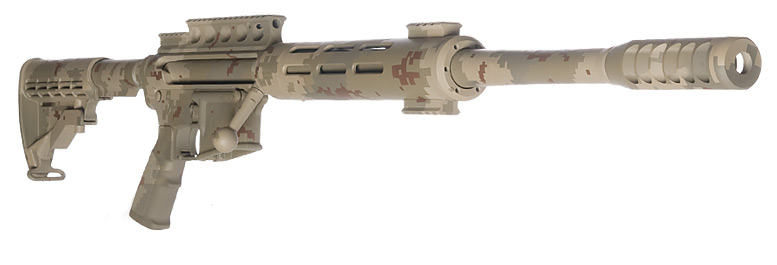
Large-caliber rifle built using the Tactilite T1 .50 BMG module
At the end of the last decade, gunsmiths from Zel Cast decided to enter the civilian market with a completely new product that developed the idea of a modular design. Initially, the project was called Ultralite50 - “ultra-light, caliber .50”. Later, due to the expansion of the plans, the project was renamed Tactilite. This name was formed from the English words "tactical" and "light", and therefore, unlike the first, it almost did not reveal the essence of the new project, although it corresponded to fashion trends. A little later, the additional designation T1 appeared, with the help of which it was proposed to distinguish the first modules from the later ones.
In accordance with the original ideas of the designers, the X-NUMX / Tactile light product was supposed to be a plug-in module for an AR-50 rifle that meets unusual requirements. It should have included so-called. the upper receiver is of the type used on a standard weapon, as well as the barrel and bolt with the desired parameters, compatible with a “non-standard” cartridge. Such a module was proposed to be combined with the existing lower receiver rifle, getting a completely new weapon with different characteristics and capabilities.
The project Tactilite in this form had one interesting feature of a legal nature. In accordance with the American weapons legislation, a replaceable module equipped with a barrel and bolt was not considered a weapon and was merely an additional accessory that did not need registration. However, the shooter would have to go through all the necessary bureaucratic procedures with the lower receiver. Such an original appearance of the Taktilayt product made it possible with minimal difficulty to assemble a new weapon from individual components.
In the middle of 2009, Zel Custom Mfg introduced the first version of the Tactilite system, designed to use the .50 BMG large-caliber rifle cartridge (12,7x99 mm NATO). In this project all the main ideas were implemented and the main units were created. In the future, the replaceable module "Taktilayt" was being finalized in one way or another, but its overall architecture and layout were not subject to alteration. The legal status of the product did not change either.
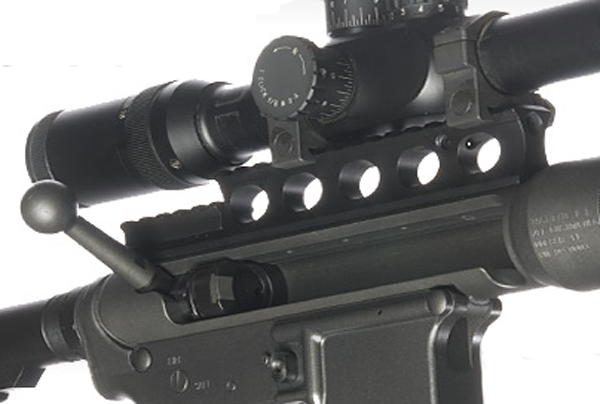
Receiver box Tactilite T1 close-up. You can consider the support sight
The project offered a replaceable module with its own top element of the receiver, barrel, bolt and means of mounting the sight. For obvious reasons, the Tactilite system was single-shot and had no means of self-recharging. However, in this configuration, it allowed the standard AR-15 product to be converted into a large-caliber rifle with the appropriate characteristics.
Using standard mounts, the Tactile night product was supposed to be fixed to the bottom element of a standard AR-15 receiver. The latter contained a trigger mechanism and the receiving shaft of the store. The finished large-bore rifle was supposed to use a regular trigger located in the lower receiver. Mine shop, however, remained out of work. Available pistol grip and butt, connected to the lower receiver, provided an acceptable ease of use of weapons.
The top receiver of the Tactilite system was a tube of sufficient length that contained a longitudinally sliding gate. In the right wall of such a receiver there was a large window with a pair of outgoing slots in the front and rear parts. This window should be used for manual loading of .50 BMG cartridges. Also through it the empty sleeve was thrown out. Finally, the window served as a slot for the shutter control handle. In front of the receiver were the means of mounting the barrel, the breech of which had a pair of lugs.
In the front and rear parts of the proposed receiver, there were holes for the pins that fastened it to the lower receiver. From the point of view of fastening systems, the new receiver completely repeated the design of standard boxes for AR-15. Thus, as stated, the Tactilite T1 product could be installed on any lower element of a receiver of a similar design.
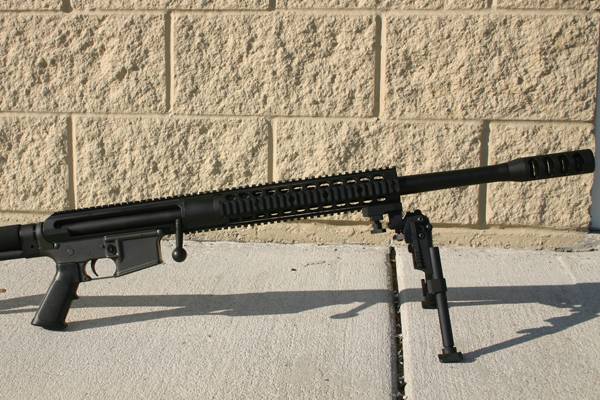
T1 Receiver with .338 caliber barrel
The module "Taktilayt" was equipped with a sliding bolt of the most simple design. The bolt carrier was made in the form of a long cylinder capable of moving inside the upper receiver. In front of it was placed a rotating bolt with a pair of large lugs. The shutter was locked by turning it clockwise with the control knob. With the gate closed, the latter was in the front groove of the receiver and served as an additional stop. Inside the gate and its frame were spring-loaded drummer and extractor. Moving backward, the bolt passed through the tubular rear element of the lower receiver and partially fell into the tube-casing of the return spring.
For obvious reasons, the Tactilite system did not have its own trigger mechanism, however, it used the standard means of the available lower receiver. For this purpose, a slot was provided at the bottom of its receiver for passing the swinging hammer.
On top of the Tactilite module of the first version, there was a bar for mounting the sight, which had a characteristic shape. For raising the sight to the required height, a support of complex cross-section was used, facilitated by a number of transverse holes. The upper edge of such a support had the profile of a Picatinny rail and made it possible to mount any compatible sight. Behind a higher support there was a smaller unit, also equipped with a standard bar.
At the front end of the replaceable module, a freely hung trunk was fixed. Buyers were offered products with rifled barrels caliber 12,7 mm long 29, 22 or 18,5 inches - 736,6, 558,8 or 469,9 mm, respectively. Promotional materials noted that the Tactilite system is equipped with Mossberg and Lothar-Walther trunks, providing high performance accuracy and accuracy of fire.
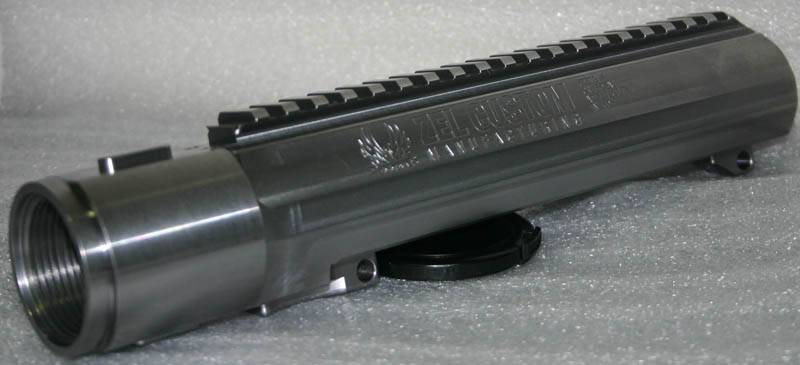
Trunk box "third generation"
Zel Custom M. Brenzel's company offered its customers Ultralite50 / Tactilite T1 products in various configurations. In particular, they differed in the material, shape and ergonomics of the forearm, the presence or absence of the muzzle brake-compensator, etc. By prior arrangement, the purchaser could make certain technical or cosmetic changes to the structure of the system being acquired. The cost of the finished module was determined by the bundle. For the least complex and “advanced” kits, the manufacturer requested 1550 US dollars.
Just a few weeks after the announcement of the Tactilite system chambered for .50 BMG, Zel Custom Manufacturing introduced a new modification of such a plug-in module. It differed from the base version with a barrel designed for .416 Barrett rifle cartridge (10,6x83 mm). This ammunition was created in the middle of the last decade as a modern replacement for the 12,7 x99 mm and resembled some of its characteristics, differing in some parameters.
It should be noted that the Tactilite .416 system allowed the manufacturing company to expand sales to a certain extent. The fact is that in several states of the United States and in a number of foreign countries the .50 BMG cartridge cannot be used in civilian weapons. As a result, the delivery of “accessories” of the Tactilite type .50 BMG, for example, to California did not make sense - no one would buy them. The .416 Barrett cartridge, in turn, did not fall under the restrictions and could be used by civilian arrows, and Zel Custom could increase sales through new regions and countries.
In October, 2009, the announcement of a new development of the company Zel Custom, created under the program Tactilite. She presented the so-called. the third generation of receivers for rifles chambered for .50 BMG. To improve the quality of the finished product, it was proposed to manufacture an integral receiver box from one steel bar (steel grade 4140). The workpiece should be processed on a milling machine with numerical control.

Rifle with a module assembled on the basis of the third generation receiver
Before the introduction of new production technology gunsmiths have developed an updated design of the receiver. The main innovation was the emergence of an integrated Picatinny rail, passing along the entire length of the main part of the box. The contours and shapes of the internal cavity, the windows and slots required for the installation of various parts, remained the same. As a result, the characteristics of third-generation rifles with receiver boxes remained at the level of previous products. According to the press release of the manufacturer, now the Gen 3 receivers have become the standard for the entire line of Tactile lights. Devices of previous designs were discontinued.
The next novelty was shown in early December of the same year. By replacing the barrel and refining the shutter, a replaceable module Tactilite .338 was created. As the name indicates, such an “accessory” was intended for use of the .338 Lapua cartridge (8,6x70 mm). Thus, now in the Zel Custom catalog there were three basic modifications of a removable top receiver, each of which could be completed with one of three trunks of different lengths. Nine such products could differ in a complete set and exterior finish.
In February, 2010, instead of another announcement, Zel Custom Mfg published an alarming product recall report. All owners of one of the versions of the Tactilite T1 .50 BMG receiver were invited to contact the manufacturer. As it turned out, the production of these products was a mistake. During the assembly, the cocking handle was inserted into the transverse channel of the bolt. On some serial modules, the shaft of the handle went too deep into the bolt and literally clamped the drummer. With an energetic forward delivery, the locked drummer could trigger a shot until the barrel was completely locked. In order to avoid possible accidents, the shooters were asked to contact the manufacturer for assistance.
Having dealt with the defective party, the arms company presented a completely new project based on already well-known ideas. At the end of the summer of 2010, a finished product called T2 was presented. The Tactilite T2 plug-in module to a certain extent repeated the design of the previous T1 product, but at the same time it was notable for new features. The main innovation of this project was the ammunition system based on a detachable box magazine. Now the shooter did not have to manually feed the cartridges one by one.
The “accessory” for the store-powered AR-15 was built on the basis of a third-generation receiver. A rectangular window appeared in its left wall, complemented by a small horizontal shaft. The back wall of the shaft had a latch for fixing the store. .50 BMG cartridges were offered to be stored and delivered from a box store from Accuracy International. Ready-to-use ammunition consisted of 5 cartridges. It should be noted that the introduction of means of ammunition had no effect on the mechanics of weapons. The Tactile night version of the T2 still had a manual recharge and a sliding bolt with turn locking.
In the basic configuration, the Tactilite T2 product had a steel receiver and an aluminum forearm with four standard slats at the top, bottom, and sides. The buyer could choose the length of the trunk and its manufacturer. In addition, for the first time in the lineup, the opportunity to choose ergonomics appeared: a receiver with a “mirror” arrangement of parts could easily be used by a left-handed shooter. Prices for Tactilite T2 store-fed products started at 2300 dollars.
As far as is known, the replaceable module with replaceable magazines was produced only for the .50 BMG / 12,7х99 mm cartridge. For one reason or another, Zel Custom did not begin to develop and launch into the series similar products for the cartridges .416 Barrett or .338 Lapua Magnum. Relatively wide selection was maintained only in the case of the Tactilite T1 line.
The American market for civilian weapons is always loyal to the original innovations, and the Tactilite project naturally attracted attention and also showed certain commercial successes. However, sales of specific accessories for weapons did not differ in large volumes. However, these products did find their customers and were mass-produced.
The advantages of such “accessories” that could have a positive effect on sales were the possibility of obtaining weapons with sufficiently high characteristics using finished products, as well as the absence of the need for special registration of the resulting rifle. The main drawback, in turn, was the considerable price due to technologies and approaches to production.
Fast enough, in just a few years, the market has become saturated. Some potential buyers of Taktylait systems purchased the desired products, while others wanted to use the secondary market and buy second-hand systems. The release of new plug-ins has virtually lost its meaning. Attempting to enter the civilian market with a “revolutionary new” idea brought Zel Custom Manufacturing a certain benefit, but the current situation could not be used forever. By the middle of this decade, the company was forced to curtail the already not the most mass production of Tactilite receivers of all developed versions.
Looking ahead, it is worth noting that the company “Zel Custom” could not keep on the market of replacement parts or spare parts for small arms of popular models. In the middle of this decade, it was forced to curtail its activities and cease production of all new devices. The official reasons for the closure of the company were difficulties in production and M. Brenzel’s personal problems. However, the termination of the release of new products had almost no effect on the operation of already sold. A considerable number of rifles and shotguns are still equipped with Zel Custom stamped parts, and a certain number of shooters continue to use Tactilite systems.
Wanting to get their market share, small arms companies often offer the most original ideas of one kind or another. Some of these projects cope with the assigned tasks and lead their creator to the market leaders; others, however, fail. Company Zel Custom Manufacturing, having adjusted the release of various spare parts for rifles, came to the original idea of a replaceable module, including the receiver, barrel and bolt, but not subject to registration as an independent weapon. Such development expectedly attracted the attention of buyers and found its niche. However, the narrowness of this niche did not allow to continue production for a long time, and besides, it could be one of the reasons for the closure of the developer company.
On the materials of the sites:
http://zelcustom.com/
http://thefirearmblog.com/
http://rifleshootermag.com/
http://defensereview.com/
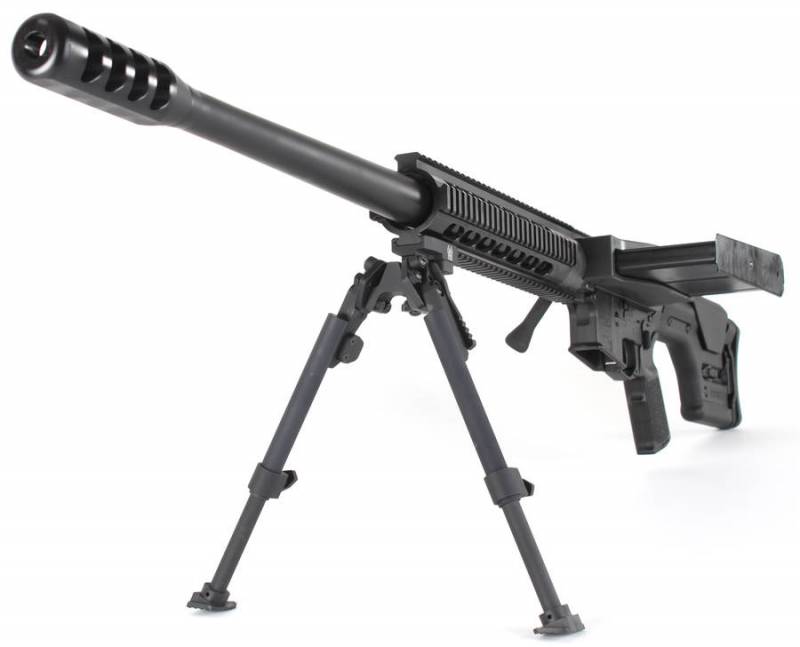
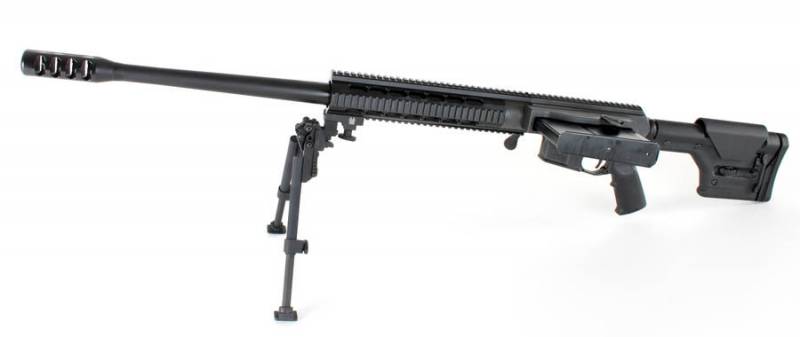
Information